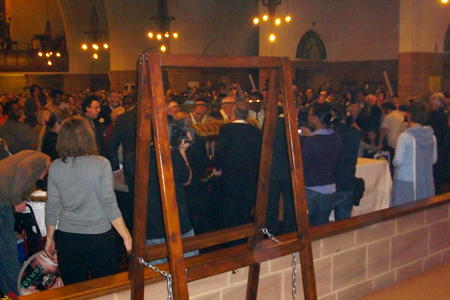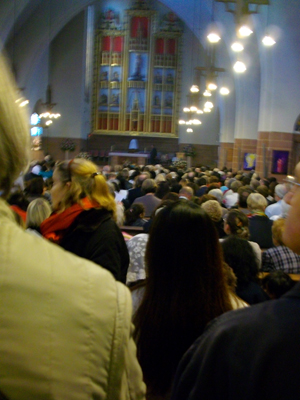| |
 |
 |
 |
| Comment on this report, or find other reports. |
 |
| Our Mystery Worshippers are volunteers who warm church pews for us around the world. If you'd like to become a Mystery Worshipper, start here. |
 |
| Find out how to reproduce this report in your church magazine or website. |
|
|
| 1797: Our Lady
of Mount Carmel and St Simon Stock, West Kensington, London |
 |
 |
 |
Mystery Worshipper:
Salskov.
The church:
Our
Lady of Mount Carmel and St Simon Stock, West Kensington,
London.
Denomination:
Roman Catholic, Diocese
of Westminster. The church is under the care of the Order
of Discalced Carmelites, an order founded in the 16th century
by St Teresa of Ávila (also known as St Teresa of Jesus)
and St John of the Cross.
The building:
The Discalced Carmelites came to London in August 1862 and built
a church designed by Edward Pugin on part of what was Isaac
Newton’s estate. That church was destroyed by incendiary bombs
in 1944. Mass was celebrated in the priory itself until 1960,
when a new church was opened, designed by Sir Giles Scott, known
for his work on Liverpool Cathedral and the Battersea Power
Station as well as the red telephone boxes that were once a
fixture in every English town and village. It is a lofty building,
faced with pink granite blocks to a height of about 14 feet,
with cream coloured walls above. There are bas reliefs of the
Stations of the Cross above the side arches, and side altars
dedicated to the Sacred Heart, St Thérèse of Lisieux,
St John Vianney (also known as the Curé of Ars), etc.
The church is lit by windows in the side walls, both at ground
level and higher up. These are glazed with pastel coloured diamond
shaped panes.
The church:
The church sponsors several community groups, some based on
the issues of living in faith, becoming a Catholic, discovering
one's vocation or direction in life. They also host outside
groups such as Alcoholics Anonymous and Little Cherubs (a private
nursery school).
The neighbourhood:
This is West London, a vibrant area. Even at 5.00 on Sunday
afternoon, many of the large shops were open, and there was
a bustling crowd, not all of whom had come to view the relics.
The cast:
The Most Revd Alan Hopes, Auxiliary Bishop of the Diocese of
Westminster, was the celebrant, assisted by at least 14 other
vested priests and deacons, one young lad as crucifer, and six
boys and girls as candle bearers. Mass was celebrated in the
presence of His Eminence Cormac Cardinal Murphy-O’Connor,
Archbishop Emeritus of Westminster, and the Most Revd Philip
Boyce, D.D., O.C.D., Bishop of Raphoe. I think the introductions
were made by the Revd Matt Blake, O.C.D., prior and parish priest.
It was a somewhat crowded sanctuary.
The date & time:
Sunday 11 October 2009, 6.00pm.
What was the name of the
service?
Mass of preparation for the reception of the relics of St Thérèse
of Lisieux.
How full was the building?
Definitely bulging. I got there 40 minutes before the service
was due to begin, and all seats were taken. So were the stone
ledges around the sides of the church and most of the floor
space. People had dug themselves in for a long stand, or sit,
on the stone floor. What this said about fire regulations I
shudder to think.
Did anyone welcome you personally?
Members of the Knights
of St Columba, in their badges, were acting as ushers, but
the crowd was almost too great to get to them. A couple of visitors
pointed me to where the literature was ready for collection.
Was your pew comfortable?
Pew? What pew? This was beginning to look impossibly uncomfortable
for someone with an arthritic hip. I moved down a side aisle
toward the altar, but every empty pew space had somebody's Little
Way booklet parked on it. However, there was a small vestibule
to the right of the altar, and in the corridor beyond was a
row of moulded plastic chairs. I grabbed one, an Irish lady
grabbed another, and we positioned ourselves behind the low
wall to the right of the altar as you're facing it. This gave
us a grandstand view of the proceedings, and meant that at least
one of the photos I took managed to catch the relics. I was
there for over two hours, and the chair wasn't at all bad. One
or two of the ushers said we would have to move in order to
accommodate the procession, but when I asked a passing friar
if we could stay there, he replied that of course we could.
In any event, the procession entered from the back of the church.
How would you describe the pre-service
atmosphere?
There was a lot of quiet talking, but many people sat silently,
or prayed, and didn't seem to be disturbed. There was a strong
atmosphere of expectation. In my corner, where there were several
of us tucked away, we chatted or prayed. I noticed one chap
busy writing in a notebook, and there were camcorders and official
TV cameras. This was one occasion when another camera went completely
unnoticed. The elderly couple next to me did ask if I was a
journalist, but discretion over writing wasn't really a problem.
What were the exact opening words of the
service?
"In the name of the Father, the Son and the Holy Ghost.
Peace be with you. Welcome to you all."
What books did the congregation
use during the service?
There were service sheets, apparently, but I didn't see one.
Copies of Hymns Old and New were around, but unused.
The Little
Way Association booklet, containing a life of St Thérèse
and mission news, was available at the back of the church, as
was the parish newsletter. A lady presented me with a holy picture,
rather like those current in my childhood. It featured God the
Father (bearded), the Paraclete as a dove, and the Sacred Hearts
of Mary and Jesus, with roses, presumably for St Thérèse
(who was known as the Little Flower).
What musical instruments
were played?
Guitar. The PA system was very good, but one instrument was not enough to keep the choir in tune.

Did anything distract you?
The steady drone of middle-of-the-road worship songs. The mass
setting was obviously familiar to many in the congregation,
and easy to pick up, so we could join in. But the songs were
rather porridgy, tending to flatness. Some items, which were
sung at every opportunity, became irritating. During the sermon,
Bishop Hopes kept adjusting his zucchetto. I felt like offering
him blue tack.
Was the worship stiff-upper-lip, happy clappy, or
what?
Formal but friendly. Chanting from the altar was a welcome relief from the worship songs coming from the gallery. No arm lifting. This had to be as ceremonious as was possible short of a bishop's installation. Visually beautiful.
Exactly how long was the sermon?
13 minutes.
On a scale of 1-10, how good was the preacher?
8 – The bishop spoke clearly and was easy to understand,
but I did find that the constant adjustment of the skull cap
diverted my attention somewhat.
In a nutshell, what was
the sermon about?
He gave a potted history of St Thérèse, saying
that she had relevance for our times. She can be a conduit of
hope and prayer, helping us rediscover God's love for us, and
challenging us to renew our love for him. He detailed the principles
of the Little Way: of loving God, trusting him, and finding
Jesus in our neighbours. St Thérèse points us
not to God's anger, but to his love. Although unknown during
her life, St Thérèse has become famous after her
death, and will pray for us in heaven as we venerate her relics
on earth.
Which part of the service
was like being in heaven?
The feeling of community in the church was palpable. The clarity
of the service and the beauty of the procession were most inspiring.
It has to be said that although the music, to me, was abysmal,
the very lively "Walk with God" which preceded and accompanied
the entry of the relics was a welcome chance to sing ourselves.
And which part was like being in... er... the other place?
The music! No congregational hymns! The congregation obviously
like singing, because they joined in with the mass setting.
Why were we subjected to these dreary worship songs, only one
of which was known outside the choir? And the tuning became
ever more unreliable. Every time the choir stopped singing,
we could tell from the guitar that their pitch had sunk. Either
they couldn't hear the guitar or they weren't listening.
What happened when you
hung around after the service looking lost?
Just before the end of mass, the prior announced that owing
to the crowds collected round the church waiting for the relics
to be brought in, the police were threatening to cancel the
service. (If they could have seen the bodies blocking every
exit aisle in the church, they would certainly have done so.)
The entrance of the relics was therefore brought forward immediately
after the blessing. They were brought in to waves of applause
and "Walk with God." They were contained in an ornate Italian
style casket, which was itself protected by (I assume) a clear
perspex casing. We were asked to let the media do their thing
before commencing the walk past, and anyone who wished to leave
should do so now. I took this opportunity to make my escape.
Outside the church there was a considerable crowd, some with
roses, one with a rose in her hair! As I walked to South Ken
Tube, I met an American girl who asked the way to the church.
Services would be continuing all night, so anyone with the patience
to wait would eventually be able to get into the church.
How would you describe
the after-service coffee?
None.
How would you feel about making this church your regular (where 10 = ecstatic, 0 = terminal)?
8 – I've been happily ensconced in the Church of England
for a quarter of a century, but if I were to begin to attend
a Roman Catholic church again, the feeling in this one was very
good.
Did the service make you feel glad to be a
Christian?
Yes, because of the feeling of community. The concept of venerating relics doesn't appeal to me particularly, but it was clearly important to the people attending.
What one thing will you remember about all this in seven days' time?
The contrast between the beauty of the service and the barrage
of substandard worship songs. |
|
|
 |
 |
 |
| We rely on voluntary donations to stay online. If you're a regular visitor to Ship of Fools, please consider supporting us. |
 |
 |
 |
| The Mystery Pilgrim |
 |
| One of our most seasoned reporters makes the Camino pilgrimage to Santiago de Compostela in Spain. Read here. |
 |
 |
 |
| London churches |
 |
| Read reports from 70 London churches, visited by a small army of Mystery Worshippers on one single Sunday. Read here. |
| |
|
|
|
|


